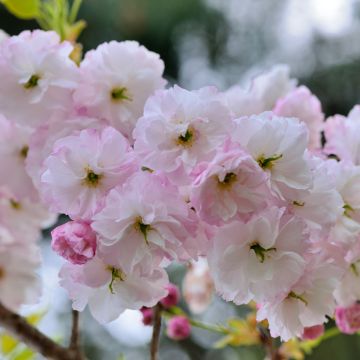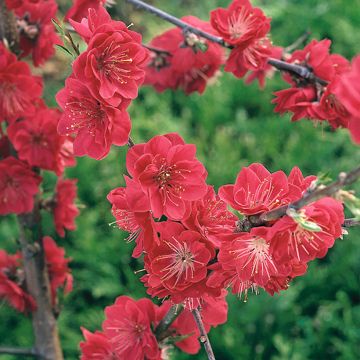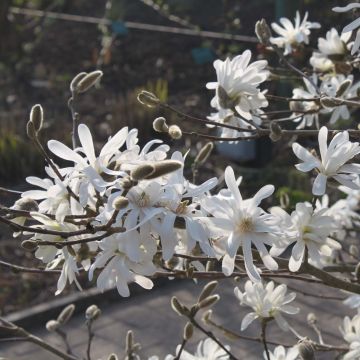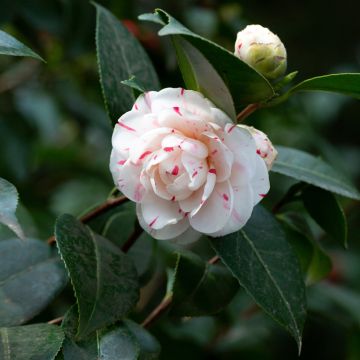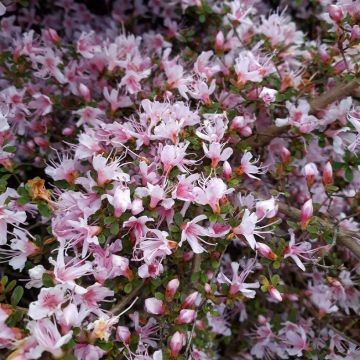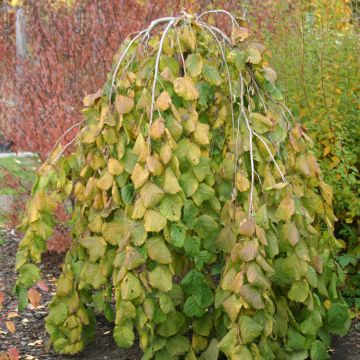

Prunus serrulata Kiku-Shidare-Zakura - Japanese Cherry


Prunus serrulata Kiku-Shidare-Zakura - Japanese Cherry


Prunus serrulata Kiku-Shidare-Zakura - Japanese Cherry


Prunus serrulata Kiku-Shidare-Zakura - Japanese Cherry


Prunus serrulata Kiku-Shidare-Zakura - Japanese Cherry
Prunus serrulata Kiku-Shidare-Zakura - Japanese Cherry
Prunus serrulata Kiku-Shidare-Zakura
Japanese Cherry, Hill Cherry, Oriental Cherry, East Asian Cherry
This item cannot be shipped to the selected country
Oversize package delivery charge from €6.90
Oversize package delivery charge from €6.90
Oversize package delivery charge from €6.90
Delivery to Corse prohibited
More information
Schedule delivery date,
and select date in basket
This plant carries a 24 months recovery warranty
More information
We guarantee the quality of our plants for a full growing cycle, and will replace at our expense any plant that fails to recover under normal climatic and planting conditions.
Oversize package: home delivery by special carrier from €6.90 per order..
Express home delivery from €8.90.
Oversize package: home delivery by special carrier from €6.90 per order..
Express home delivery from €8.90.
Oversize package: home delivery by special carrier from €6.90 per order..
Express home delivery from €8.90.
Delivery to Corse prohibited: UE law prohibits the import of this plant from mainland France to Corse as part of the fight against Xylella fastidiosa. Please accept our sincere apologies.
More information

Does this plant fit my garden?
Set up your Plantfit profile →
Description
Prunus serrulata 'Kiku-shidare-sakura', is a fascinating deciduous small tree with a weeping habit that perhaps embodies better than any other the spirit of the Japanese flowering cherry tree, especially as it ages. In spring, branches covered with pom-pom flowers of a fresh pink gracefully droop to the ground, forming a pink fountain around a massive trunk, creating a magical sight reminiscent of a flowering tree wisteria. In autumn, this floral fountain ignites in yellow-orange, while winter reveals its dark and twisted silhouette of a giant bonsai. This quite spectacular Prunus, however, remains of modest dimensions, well-suited for small gardens.
Prunus serrulata, belonging to the large Rosaceae family, is a small tree with a dense crown and thin bark originating from Asia, specifically Japan, Korea, and China. It is also known as Japanese cherry tree, Hill cherry tree, Japanese flowering cherry, or Oriental cherry tree.
The Japanese cultivar 'Kiku-shidare-sakura' is probably the most well-known and widely planted weeping cherry tree. With fairly rapid growth, this tree reaches between 3 m and 4 m (9.8 ft to 13.1 ft) in height and 3 m (9.8 ft) in width, sometimes much wider depending on how it is trained. Flowering takes place from April to May depending on the region, usually before the leaves appear, but sometimes at the same time as the young leaves tinged with coppery bronze emerge. Its numerous deep pink buds open into large double flowers, of a fresh and vivid pink, all along the branches. Gathered in small clusters of 3-4, they measure 5 cm to 6 cm (2 in to 2.4 in) in diameter. After flowering, Prunus 'Kiku-shidare-sakura' is adorned with deciduous elliptical leaves 8 cm to 12 cm (3.1 in to 4.7 in) long. After flowering, the branches develop deciduous leaves, elliptical in shape, with dentate edges, measuring 8 cm to 12 cm (3.1 in to 4.7 in) in length. They are medium green in summer and turn red-orange in autumn.
This small tree with a strong personality is perfect as a standalone or at the back of a border, positioned behind perennials or small shrubs with staggered flowering. To adorn its base, one can plant, for example, silver basket, a small creeping clematis (Clematis diversifolia 'Rooguchi') or discreet and charming forget-me-nots that will not overshadow its splendour. One could also imagine planting a small pink clematis to brighten its foliage in summer (Clematis 'Little Mermaid', C. 'Success Cady', C. 'Josephine').
Report an error about the product description
Prunus serrulata Kiku-Shidare-Zakura - Japanese Cherry in pictures






Plant habit
Flowering
Foliage
Botanical data
Prunus
serrulata
Kiku-Shidare-Zakura
Rosaceae
Japanese Cherry, Hill Cherry, Oriental Cherry, East Asian Cherry
Cultivar or hybrid
Other Prunus
Planting and care
It thrives in full sun in any rich, moist but well-draining fertile soil, without excessive limestone or acidity. During planting, mix your soil with compost at a ratio of 50%. Dig a large planting hole. Be cautious of late frosts that could damage early flowering. Similarly, wind and rain significantly shorten the tree's flowering period by damaging the flowers. That's why it's preferable to place the prunus in a slightly sheltered location.
Planting period
Intended location
Care
-
, onOrder confirmed
Reply from on Promesse de fleurs
Spring-flowering shrubs
Haven't found what you were looking for?
Hardiness is the lowest winter temperature a plant can endure without suffering serious damage or even dying. However, hardiness is affected by location (a sheltered area, such as a patio), protection (winter cover) and soil type (hardiness is improved by well-drained soil).

Photo Sharing Terms & Conditions
In order to encourage gardeners to interact and share their experiences, Promesse de fleurs offers various media enabling content to be uploaded onto its Site - in particular via the ‘Photo sharing’ module.
The User agrees to refrain from:
- Posting any content that is illegal, prejudicial, insulting, racist, inciteful to hatred, revisionist, contrary to public decency, that infringes on privacy or on the privacy rights of third parties, in particular the publicity rights of persons and goods, intellectual property rights, or the right to privacy.
- Submitting content on behalf of a third party;
- Impersonate the identity of a third party and/or publish any personal information about a third party;
In general, the User undertakes to refrain from any unethical behaviour.
All Content (in particular text, comments, files, images, photos, videos, creative works, etc.), which may be subject to property or intellectual property rights, image or other private rights, shall remain the property of the User, subject to the limited rights granted by the terms of the licence granted by Promesse de fleurs as stated below. Users are at liberty to publish or not to publish such Content on the Site, notably via the ‘Photo Sharing’ facility, and accept that this Content shall be made public and freely accessible, notably on the Internet.
Users further acknowledge, undertake to have ,and guarantee that they hold all necessary rights and permissions to publish such material on the Site, in particular with regard to the legislation in force pertaining to any privacy, property, intellectual property, image, or contractual rights, or rights of any other nature. By publishing such Content on the Site, Users acknowledge accepting full liability as publishers of the Content within the meaning of the law, and grant Promesse de fleurs, free of charge, an inclusive, worldwide licence for the said Content for the entire duration of its publication, including all reproduction, representation, up/downloading, displaying, performing, transmission, and storage rights.
Users also grant permission for their name to be linked to the Content and accept that this link may not always be made available.
By engaging in posting material, Users consent to their Content becoming automatically accessible on the Internet, in particular on other sites and/or blogs and/or web pages of the Promesse de fleurs site, including in particular social pages and the Promesse de fleurs catalogue.
Users may secure the removal of entrusted content free of charge by issuing a simple request via our contact form.
The flowering period indicated on our website applies to countries and regions located in USDA zone 8 (France, the United Kingdom, Ireland, the Netherlands, etc.)
It will vary according to where you live:
- In zones 9 to 10 (Italy, Spain, Greece, etc.), flowering will occur about 2 to 4 weeks earlier.
- In zones 6 to 7 (Germany, Poland, Slovenia, and lower mountainous regions), flowering will be delayed by 2 to 3 weeks.
- In zone 5 (Central Europe, Scandinavia), blooming will be delayed by 3 to 5 weeks.
In temperate climates, pruning of spring-flowering shrubs (forsythia, spireas, etc.) should be done just after flowering.
Pruning of summer-flowering shrubs (Indian Lilac, Perovskia, etc.) can be done in winter or spring.
In cold regions as well as with frost-sensitive plants, avoid pruning too early when severe frosts may still occur.
The planting period indicated on our website applies to countries and regions located in USDA zone 8 (France, United Kingdom, Ireland, Netherlands).
It will vary according to where you live:
- In Mediterranean zones (Marseille, Madrid, Milan, etc.), autumn and winter are the best planting periods.
- In continental zones (Strasbourg, Munich, Vienna, etc.), delay planting by 2 to 3 weeks in spring and bring it forward by 2 to 4 weeks in autumn.
- In mountainous regions (the Alps, Pyrenees, Carpathians, etc.), it is best to plant in late spring (May-June) or late summer (August-September).
The harvesting period indicated on our website applies to countries and regions in USDA zone 8 (France, England, Ireland, the Netherlands).
In colder areas (Scandinavia, Poland, Austria...) fruit and vegetable harvests are likely to be delayed by 3-4 weeks.
In warmer areas (Italy, Spain, Greece, etc.), harvesting will probably take place earlier, depending on weather conditions.
The sowing periods indicated on our website apply to countries and regions within USDA Zone 8 (France, UK, Ireland, Netherlands).
In colder areas (Scandinavia, Poland, Austria...), delay any outdoor sowing by 3-4 weeks, or sow under glass.
In warmer climes (Italy, Spain, Greece, etc.), bring outdoor sowing forward by a few weeks.




































